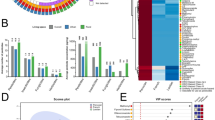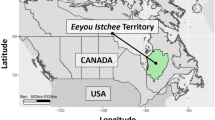Abstract
Since 1967, a chemical plant in the town of Chapaevsk (Samara province, Russia) has produced large amounts of chlorinated compounds and is suspected to be a major source of local environmental dioxin contamination. Dioxins have been detected in the local air, soil, drinking water, vegetables, and cow's milk. Human exposure to dioxins is suspected as a factor in the deteriorating local public health. In an effort to characterize nonoccupational dioxin exposure among local residents, during the summer of 1998, 24 volunteers were recruited to donate blood and to provide information about their residence, employment, demographics, medical history, and dietary habits. Selected polychlorinated dibenzodioxins, dibenzofurans, and coplanar biphenyls were measured in blood serum samples. The mean concentration of total dioxin World Health Organization toxic equivalents (WHO-TEQ98) based on polychlorinated dibenzo-para-dioxins (PCDDs), polychlorinated dibenzofurans (PCDFs), and coplanar polychlorinated biphenyls (PCBs) was 61.2 (range 16.4–168.1) pg/g lipid. Subjects living in close proximity to the plant (less than 5 km) had significantly higher dioxin levels (mean WHO-TEQ98, 75.7 pg/g lipid), as compared to subjects living more than 5 km from the plant (mean WHO-TEQ98, 44.1 pg/g lipid) (P<0.04). Comparisons of the study results with available published data indicate that average blood dioxin levels were substantially higher in Chapaevsk residents than in nonoccupationally exposed populations of other parts of Russia, Europe, and North America. Chronic exposures of such magnitude may have appreciable adverse effects on public health.
This is a preview of subscription content, access via your institution
Access options
Subscribe to this journal
Receive 6 print issues and online access
$259.00 per year
only $43.17 per issue
Buy this article
- Purchase on Springer Link
- Instant access to full article PDF
Prices may be subject to local taxes which are calculated during checkout
Similar content being viewed by others
Abbreviations
- ANOVA:
-
analysis of variance
- BMI:
-
body mass index
- CDC:
-
Centers for Disease Control and Prevention
- IARC:
-
International Agency for Research on Cancer
- NTP:
-
National Toxicology Program
- PCB:
-
polychlorinated biphenyl
- PCDD:
-
polychlorinated dibenzo-para-dioxin
- PCDF:
-
polychlorinated dibenzofuran
- ppt:
-
parts per trillion
- SD:
-
standard deviation
- TEF:
-
toxic equivalency factor
- TEQ:
-
toxic equivalent
- WHO:
-
World Health Organization
- 2,3,7,8-TCDD:
-
2,3,7,8-tetrachlorodibenzo-p-dioxin
- 1,2,3,7,8-PeCDD:
-
1,2,3,7,8-pentachlorodibenzo-p-dioxin
- 1,2,3,4,7,8-HxCDD:
-
1,2,3,4,7,8-hexachlorodibenzo-p-dioxin
- 1,2,3,6,7,8-HxCDD:
-
1,2,3,6,7,8-hexachlorodibenzo-p-dioxin
- 1,2,3,7,8,9-HxCDD:
-
1,2,3,7,8,9-hexachlorodibenzo-p-dioxin
- 1,2,3,4,6,7,8-HpCDD:
-
1,2,3,4,6,7,8-heptachlorodibenzo-p-dioxin
- 1,2,3,4,6,7,9-HpCDD:
-
1,2,3,4,6,7,9-heptachlorodibenzo-p-dioxin
- OCDD:
-
octachloro dibenzo-p-dioxin
- 2,3,7,8-TCDF:
-
2,3,7,8-tetrachlorodibenzofuran
- 1,2,3,7,8-PeCDF:
-
1,2,3,7,8-pentachlorodibenzofuran
- 2,3,4,7,8-PeCDF:
-
2,3,4,7,8-pentachlorodibenzofuran
- 1,2,3,4,7,8-HxCDF:
-
1,2,3,4,7,8-hexachlorodibenzofuran
- 1,2,3,6,7,8-HxCDF:
-
1,2,3,6,7,8-hexachlorodibenzofuran
- 1,2,3,7,8,9-HxCDF:
-
1,2,3,7,8,9-hexachlorodibenzofuran
- 2,3,4,6,7,8-HxCDF:
-
2,3,4,6,7,8-hexachlorodibenzofuran
- 1,2,3,4,6,7,8-HpCDF:
-
1,2,3,4,6,7,8-heptachlorodibenzofuran
- 1,2,3,4,7,8,9-HpCDF:
-
1,2,3,4,7,8,9-heptachlorodibenzofuran
- OCDF:
-
octachlorodibenzofuran
- 3,3′,4,4′-TCB 77:
-
3,3′,4,4′-tetrachlorinated biphenyl (PCB-77)
- 3,4,4′,5-TCB 81:
-
3,4,4′,5-tetrachlorinated biphenyl (PCB-81)
- 3,3′,4,4′,5-PCB 126:
-
3,3′,4,4′,5-pentachlorinated biphenyl (PCB-126)
- 3,3′,4,4′,5,5′-HCB 169:
-
3,3′,4,4′,5,5′-hexachlorinated biphenyl (PCB-169)
References
Ahlborg, UG, Becking, GC, Birnbaum, LS, Brouwer, A, Derks, HJ, Feeley, M, Golor, G, Hanberg, A, Larsen, JC, Liem, AKD, Safe, SH, Schlatter, C, Waern, F, Younes, M, Yrjanheikki, E . Toxic equivalency factors for dioxin-like PCBs; report on a WHO-ECEH and IPCS consultation, Chemosphere (1994) 28: 1049–1067
Akins, JR, Waldrep, K, Bernert, JT Jr . The estimation of total serum lipids by a completely enzymatic “summation” method, Clin Chim Acta (1989) 184: 219–226
Amirova, Z, Kruglov, E . Time history of PCDD/Fs content in blood of the population in the city of Ufa, Bashkortostan. Dioxin '2001 Symposium, Korea, Organohalogen Compounds (2001) 52: 269–272
Amirova, Z, Kruglov, E, Loshkina, E, Chalilov, R, Minin, G . Dioxins in Russia. IV. Ufa, Bashkortostan, Organohalogen Compounds (1998) 38: 105–108
Bertazzi, PA, Consonni, D, Bachetti, S, Rubagotti, M, Baccarelli, A, Zocchetti, C, Pesatori, AC . Health effects of dioxin exposure: a 20-year mortality study, Am J Epidemiol (2001) 153: 1031–1044
Bertazzi, PA, Zocchetti, C, Pesatori, AC, Guercilena, S, Sanarico, M, Radice, L . Ten-year mortality study of the population involved in the Seveso incident in 1976, Am J Epidemiol (1989) 129: 1187–1200
Covaci, A, Koppen, G, Cluevenbergen, RV, Schepens, P, Winneke, G, Schoeters, G . Persistent organochlorine compounds in human serum of 50–65 years old women living in two regions of Flanders, Belgium. Dioxin '2001 Symposium, Korea, Organohalogen Compounds (2001) 52: 265–268
Egeland, GM, Sweeney, MH, Fingerhut, MA, Wille, KK, Schnorr, TM, Halperin, WE . Total serum testosterone and gonadotropins in workers exposed to dioxin, Am J Epidemiol (1994) 139: 272–281
Goldman, LR, Harnly, M, Flattery, J, Patterson, DG Jr Needham, LL . Serum polychlorinated dibenzo-p-dioxins and polychlorinated dibenzofurans among people eating contaminated home-produced eggs and beef, Environ Health Perspect (2000) 108: 13–19
Huisman, M, Koopman-Esseboom, C, Lanting, CI, van der Paauw, CG, Tuinstra, LG, Fidler, V, Weisglas-Kuperus, N, Sauer, PJ, Boersma, ER, Touwen, BC . Neurological condition in 18-month-old children perinatally exposed to polychlorinated biphenyls and dioxins, Early Hum Dev (1995) 43: 165–176
IARC. Polychlorinated dibenzo-para-dioxins and polychlorinated dibenzofurans, IARC Monogr Eval Carcinog Risk Hum (1997) 69: 219–343
Ingel, F, Platonova, V, Katosova, L . Human emotional stress, dioxin blood content and genetic damage in Chapaevsk town, Chemosphere (2001) 43: 989–998
Kogevinas, M . Human health effects of dioxins: cancer, reproductive and endocrine system effects, Hum Reprod Updat (2001) 7: 331–339
Koopman-Esseboom, C, Morse, DC, Weisglas-Kuperus, N, Lutkeschipholt, IJ, Van der Paauw, CG, Tuinstra, LG, Brouwer, A, Sauer, PJ . Effects of dioxins and polychlorinated biphenyls on thyroid hormone status of pregnant women and their infants, Pediatr Res (1994) 36: 468–473
Koopman-Esseboom, C, Weisglas-Kuperus, N, de Ridder, MA, Van der Paauw, CG, Tuinstra, LG, Sauer, PJ . Effects of polychlorinated biphenyl/dioxin exposure and feeding type on infants' mental and psychomotor development, Pediatrics (1996) 97: 700–706
Landi, MT, Needham, LL, Lucier, G, Mocarelli, P, Bertazzi, PA, Caporaso, N . Concentrations of dioxin 20 years after Seveso, Lancet (1997) 349: 1811
Longnecker, MP, Ryan, JJ, Gladen, BC, Schecter, AJ . Correlations among human plasma levels of dioxin-like compounds and polychlorinated biphenyls (PCBs) and implications for epidemiologic studies, Arch Environ Health (2000) 55: 195–200
Mocarelli, P, Brambilla, P, Gerthoux, PM, Patterson, DG Jr Needham, LL . Change in sex ratio with exposure to dioxin, Lancet (1996) 348: 409
Mocarelli, P, Gerthoux, PM, Ferrari, E, Patterson, DG, Kieszak, SM, Brambilla, P, Vincoli, N, Signorini, S, Tramacere, P, Carreri, V, Sampson, EJ, Turner, WE, Needham, LL . Paternal concentrations of dioxin and sex ratio of offspring, Lancet (2000) 355: 1858–1863
NTP. 2,3,7,8-Tetrachlorodibenzo-p-Dioxin (TCDD); Dioxin (CAS No. 1746-01-6). Addendum to the Ninth Report on Carcinogens. National Toxicology Program, Bethesda, MD 2001
Päpke, O . PCDD/PCDF: human background data for Germany, a 10-year experience, Environ Health Perspect (1998) 106 suppl 2 723–731
Päpke, O, Ball, M, Lis, A . Various PCDD/PCDF patterns in human blood resulting from different occupational exposures, Chemosphere (1992) 25: 1101–1108
Patandin, S, Lanting, CI, Mulder, PG, Boersma, ER, Sauer, PJ, Weisglas-Kuperus, N . Effects of environmental exposure to polychlorinated biphenyls and dioxins on cognitive abilities in Dutch children at 42 months of age, J Pediatr (1999) 134: 33–41
Patterson, DG Jr Hampton, L, Lapeza, CR Jr Belser, WT, Green, V, Alexander, L, Needham, LL . High-resolution gas chromatographic/high-resolution mass spectrometric analysis of human serum on a whole-weight and lipid basis for 2,3,7,8-tetrachlorodibenzo-p-dioxin, Anal Chem (1987) 59: 2000–2005
Pluim, HJ, Wever, J, Koppe, JG, Vandenslikke, JW, Olie, K . Intake and fecal excretion of chlorinated dioxins and dibenzofurans in breast-fed infants at different ages, Chemosphere (1993) 26: 1947–1952
Revazova, J, Yurchenko, V, Katosova, L, Platonova, V, Sycheva, L, Khripach, L, Ingel, F, Tsutsman, T, Zhurkov, V . Cytogenetic investigation of women exposed to different levels of dioxins in Chapaevsk town, Chemosphere (2001) 43: 999–1004
Revich, B, Aksel, E, Dvoirin, V, Kolbeneva, L, Pervunina, R . Dioxin in the environment of Chapaevsk (Russia), health of its population. Dioxin '96 Symposium, Amsterdam, Organohalogen Compounds (1996) 30: 350–353
Revich, B, Brodsky, E, Sotskov, Y . Dioxin in environmental, blood, breast milk, cow milk in Chapaevsk town. Dioxin '99 Symposium, Italy, Organohalogen Compounds (1999) 44: 229–232
Revich, B, Aksel, E, Ushakova, T, Ivanova, I, Zhuchenko, N, Klyuev, N, Brodsky, B, Sotskov, Y . Dioxin exposure and public health in Chapaevsk, Russia, Chemosphere (2001) 43: 951–966
Ryan, JJ, Schecter, A . Exposure of Russian phenoxy herbicide producers to dioxins, J Occup Environ Med (2000) 42: 861–870
Schecter, A, Dai, LC, Päpke, O, Prange, J, Constable, JD, Matsuda, M, Thao, VD, Piskac, AL . Recent dioxin contamination from Agent Orange in residents of a southern Vietnam city, J Occup Environ Med (2001) 43: 435–443
Schecter, A, Pavuk, M, Amirova, DA, Grosheva, EI, Päpke, O, Ryan, JJ, Adibi, J, Piskac, AL . Characterization of dioxin exposure in firefighters, residents, and chemical workers in the Irkutsk region of Russian Siberia, Chemosphere (2002) 47: 147–156
Sergeyev, O, Zeilert, V, Revich, B, Ushakova, T, Williams, P, Korrick, S, Lee, MM, Altshul, M, Adibi, J, Hauser, R . Sexual and physical maturation of male adolescents in a dioxin contaminated region: Chapaevsk, Russia. Dioxin '2000 Symposium, USA, Organohalogen Compounds (2000) 48: 211–214
Turner, W, DiPietro, E, Lapeza, C, Green, V, Gill, J, Patterson, DG Jr . A fast universal automated cleanup system for the isotope-dilution high-resolution mass spectrometric analysis of PCDDs, PCDFs, coplanar PCBs, PCB congeners, and persistent pesticides from the same serum sample, Organohalog Compd (1997) 31: 26–31
Van den Berg, M, Birnbaum, L, Bosveld, AT, Brunstrom, B, Cook, P, Feeley, M, Giesy, JP, Hanberg, A, Hasegawa, R, Kennedy, SW, Kubiak, T, Larsen, JC, van Leeuwen, FX, Liem, AK, Nolt, C, Peterson, RE, Poellinger, L, Safe, S, Schrenk, D, Tillitt, D, Tysklind, M, Younes, M, Waern, F, Zacharewski, T . Toxic equivalency factors (TEFs) for PCBs, PCDDs, PCDFs for humans and wildlife, Environ Health Perspect (1998) 106: 775–792
Weisglas-Kuperus, N, Patandin, S, Berbers, GA, Sas, TC, Mulder, PG, Sauer, PJ, Hooijkaas, H . Immunologic effects of background exposure to polychlorinated biphenyls and dioxins in Dutch preschool children, Environ Health Perspect (2000) 108: 1203–1207
Weisglas-Kuperus, N, Sas, TC, Koopman-Esseboom, C, van der Zwan, CW, De Ridder, MA, Beishuizen, A, Hooijkaas, H, Sauer, PJ . Immunologic effects of background prenatal and postnatal exposure to dioxins and polychlorinated biphenyls in Dutch infants, Pediatr Res (1995) 38: 404–410
Acknowledgements
Collection and analysis of human samples were supported through an agreement with the Environmental Toxicology Program of the US National Institute of Environmental Health Sciences and by Public Health Service Grants ES00260 and CA16087. Dioxin analyses were supported by interagency agreement Y1-ES-8062-02 between the National Institute of Environmental Health Sciences and the National Center for Environmental Health. This work was undertaken during the tenure of Dr. Paolo Toniolo from a Senior Visiting Scientist Award from the IARC (Lyon, France). The authors are grateful to the administration of the City of Chapaevsk for logistical support.
Author information
Authors and Affiliations
Corresponding author
Rights and permissions
About this article
Cite this article
AKHMEDKHANOV, A., REVICH, B., ADIBI, J. et al. Characterization of dioxin exposure in residents of Chapaevsk, Russia. J Expo Sci Environ Epidemiol 12, 409–417 (2002). https://doi.org/10.1038/sj.jea.7500243
Received:
Published:
Issue Date:
DOI: https://doi.org/10.1038/sj.jea.7500243
Keywords
This article is cited by
-
Geographical distribution of dioxins, cadmium, and mercury concentrations in reindeer liver, kidneys, and muscle in the Russian Far North
Environmental Science and Pollution Research (2022)
-
Predictors of serum dioxin levels among adolescent boys in Chapaevsk, Russia: A cross-sectional pilot study
Environmental Health (2005)
-
Levels of dioxins and furans in plasma of nonoccupationally exposed subjects living near a hazardous waste incinerator
Journal of Exposure Science & Environmental Epidemiology (2005)



